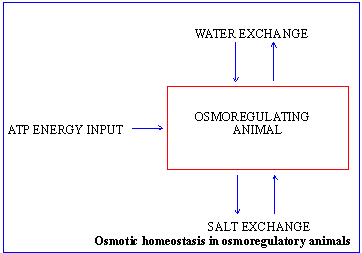|
PinkMonkey Online Study Guide-Biology
CHAPTER 19 : EXCRETION AND OSMOREGULATION
19.0 Introduction
Excretion is the removal of toxic (nitrogenous) waste
products of metabolism from the body. The waste end products of catabolism
contain carbon, hydrogen, oxygen and nitrogen. Carbon atoms are eliminated
in carbon dioxide, hydrogen in water (H2O), and oxygen in carbon
dioxide and water. Nitrogen, which is a highly toxic end product of protein
metabolism, is found in large quantities and needs to be excreted as soon
as it is formed. The kidneys (also liver) carry out detoxification,
altering toxic substances into forms that are not poisonous to the
body.

The process of maintenance of osmotic and ionic concentration
of body fluids is called osmoregulation. Animals regulate this
process in accordance with their external environment. Osmoregulation
and excretion are intimately related; these processes together maintain
homeostasis (i.e. staying the same), and are performed by the same
set of organs. The kidney is the major organ of osmoregulation and excretion
in vertebrates.
An osmoregulatory animal is generally in an osmotic
steady state, and maintains relatively constant concentration of internal
salts and water. The intake and outflow of water and salts are equal and
it is maintained at the cost of energy.
The term 'excretion' is correctly applied only to substances which must cross the cell membrane to leave the body. This does not include expulsion of undigested food material (egestion) since the food passes down the digestive tract without ever passing through a cell membrane.
[next page]
|
Table of Contents
19.0 -
Introduction
19.1 -
Ammonotelism, Ureotelism and Uricotelism
19.2 -
Excretory System of Man
19.3 -
Skin and Lungs as Accessory Excretory Organs
Chapter
20
|